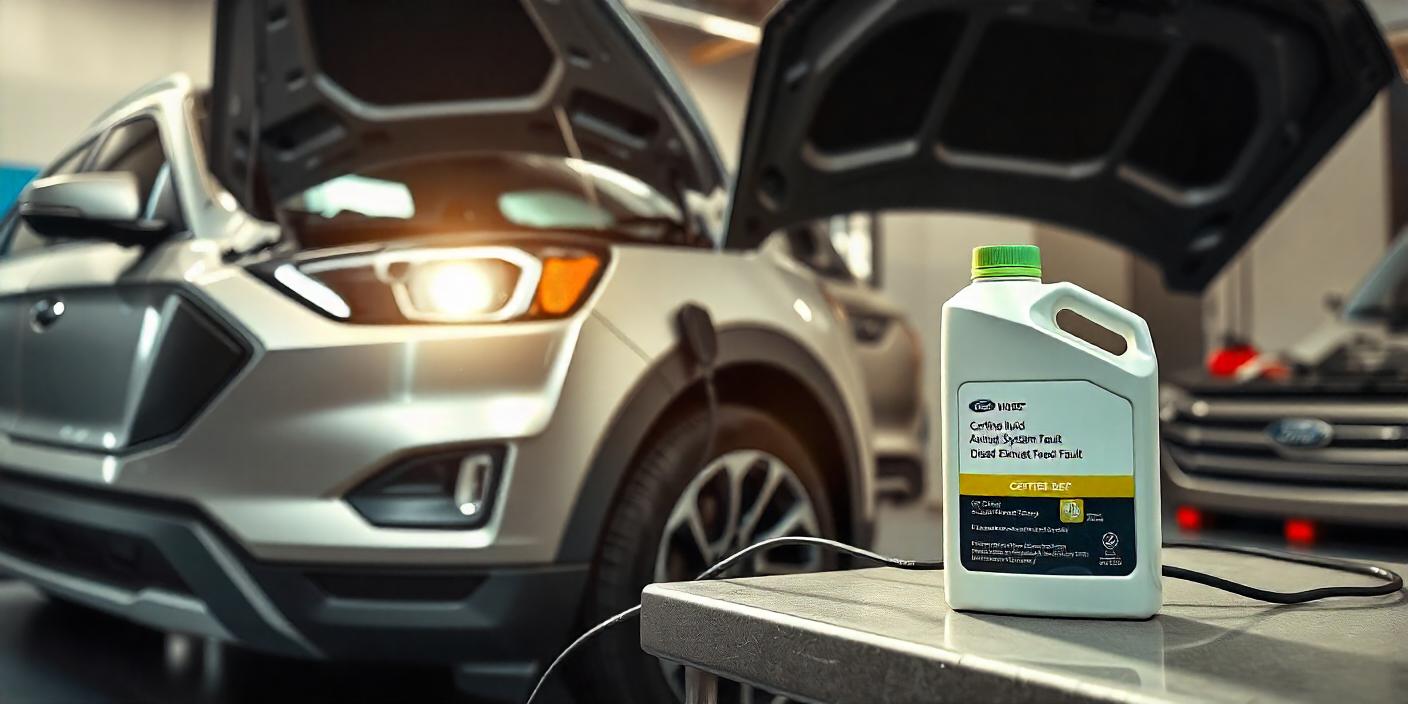The “Exhaust Fluid System Fault” warning in Ford vehicles indicates an issue with the Diesel Exhaust Fluid (DEF) system, which is critical for reducing harmful emissions. Common causes include low DEF levels, contaminated fluid, faulty sensors, or clogged injectors. To reset the warning, ensure the DEF tank is properly filled, cycle the ignition, and take the vehicle for a short drive to allow the system to recalibrate.
For persistent warnings, an OBD-II scanner may be required to clear fault codes. Regular maintenance, using high-quality DEF, and monitoring fluid levels can help prevent future issues. Ignoring the fault may lead to reduced engine performance or a no-start condition, so timely action is essential. If the problem persists, consult a mechanic or Ford dealership for professional assistance.
If you’re dealing with this warning, don’t worry—this guide will walk you through everything you need to know to address the issue, including how to reset the system properly.
Understanding the Exhaust Fluid System in Ford Vehicles
Ford’s diesel vehicles use a selective catalytic reduction (SCR) system to meet emission standards. This system relies on Diesel Exhaust Fluid (DEF), also known as AdBlue, to reduce nitrogen oxide (NOx) emissions. When the system detects an issue, such as low fluid levels or a sensor malfunction, the “Exhaust Fluid System Fault” message may appear on the dashboard.
Ignoring this fault can lead to limited engine performance or even a no-start condition, so it’s important to address it promptly.
Common Causes of the “Exhaust Fluid System Fault” Warning
Before attempting to reset the system, it’s crucial to identify the root cause. Common issues include:
- Low DEF Levels: Ensure the DEF tank is adequately filled with high-quality fluid.
- Contaminated DEF: Dirt or water contamination in the fluid can cause system malfunctions.
- Faulty Sensors: DEF quality or level sensors can fail, triggering the warning.
- Clogged Injector: The DEF injector may become blocked, preventing proper operation.
- Software Glitches: Occasionally, the fault may arise from a software error.
Step-by-Step Guide to Reset the Exhaust Fluid System Fault
If you’ve addressed the underlying issue, follow these steps to reset the fault message:
1. Refill the DEF Tank
- Use a certified Diesel Exhaust Fluid that meets ISO 22241 standards.
- Check the owner’s manual for your Ford vehicle’s DEF tank capacity and ensure it is adequately filled.
2. Cycle the Ignition
- Turn the ignition key to the “On” position (do not start the engine).
- Wait for 30 seconds to allow the system to detect the fluid.
- Turn the ignition off and repeat the process a few times.
3. Drive the Vehicle
- Take the vehicle for a short drive (at least 10–15 minutes) to allow the system to recalibrate.
- Ensure the engine reaches normal operating temperature during the drive.
4. Perform a System Reset via Diagnostics
- Use an OBD-II scanner compatible with Ford vehicles to clear any stored fault codes.
- Connect the scanner to the vehicle’s diagnostic port (typically located under the dashboard).
- Access the SCR or DEF system menu and follow the prompts to reset the fault.
5. Consult a Professional
- If the warning persists, it may indicate a deeper issue, such as a malfunctioning control module or injector.
- Visit a Ford dealership or trusted mechanic for advanced diagnostics and repairs.
Preventive Tips to Avoid Future DEF System Issues
- Regular Maintenance: Schedule periodic inspections to keep the SCR system functioning properly.
- Use High-Quality DEF: Always purchase DEF from reputable sources to avoid contamination.
- Monitor Fluid Levels: Keep the DEF tank adequately filled to prevent warnings.
- Update Vehicle Software: Ensure your Ford vehicle’s software is up to date, as manufacturers release updates to address known issues.
Here are 10 FAQs related to resetting the “Exhaust Fluid System Fault” on Ford vehicles:
1. What does the “Exhaust Fluid System Fault” warning mean?
The warning indicates an issue with your vehicle’s Diesel Exhaust Fluid (DEF) system, which is responsible for reducing harmful emissions. It may be due to low DEF levels, contaminated fluid, sensor failures, or other malfunctions.
2. Can I reset the Exhaust Fluid System Fault without fixing the issue?
No, resetting the fault without addressing the root cause is not recommended. The warning will likely reappear, and unresolved issues can lead to reduced engine performance or a no-start condition.
3. How do I refill the DEF tank on my Ford vehicle?
Locate the DEF fill port, typically near the fuel cap or under the hood. Use a certified DEF that meets ISO 22241 standards, and carefully pour the fluid into the tank until it is full.
4. Do I need a diagnostic tool to reset the warning?
In some cases, the warning may reset automatically after fixing the issue (e.g., refilling the DEF tank and driving the vehicle). However, for persistent warnings, an OBD-II scanner may be required to clear fault codes.
5. Can I use any brand of Diesel Exhaust Fluid?
No, it’s important to use DEF that meets ISO 22241 standards. Using low-quality or contaminated DEF can damage the system and trigger faults.
6. What happens if I ignore the “Exhaust Fluid System Fault” warning?
Ignoring the warning can result in limited engine performance, reduced power, or a complete no-start condition. The system is designed to ensure compliance with emissions regulations.
7. Why does the warning persist after refilling the DEF tank?
If the warning persists, it could be due to a sensor malfunction, contaminated DEF, or a system calibration issue. Using a diagnostic tool to clear the fault may also be necessary.
8. How often should I refill the DEF tank?
The frequency of DEF refills depends on your driving habits and vehicle model. Typically, one gallon of DEF lasts approximately 1,000 miles, but check your owner’s manual for specific recommendations.
9. Can I reset the Exhaust Fluid System Fault by disconnecting the battery?
While disconnecting the battery may temporarily clear the warning, it is not a reliable or recommended solution. It’s better to address the issue properly and use a diagnostic tool if needed.
10. Should I visit a mechanic for the “Exhaust Fluid System Fault”?
If basic troubleshooting steps (e.g., refilling the DEF tank or clearing codes with a scanner) do not resolve the issue, it’s best to consult a mechanic or Ford dealership for advanced diagnostics and repairs.
Final Thoughts
Resetting the “Exhaust Fluid System Fault” message on your Ford is often straightforward, provided the underlying problem is addressed first. By following this guide and adhering to regular maintenance practices, you can keep your vehicle’s emission system in optimal condition and avoid future inconveniences.
If the issue persists despite your efforts, don’t hesitate to seek professional assistance. A properly functioning DEF system is not only vital for your vehicle’s performance but also for the environment.

